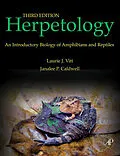With a new emphasis placed on conservation issues,Herpetology continues to broaden the global coverage from earlier editions, recognising the burgeoning reptile and amphibian research programs and the plight of many species in all countries and all biomes.
New information on the remarkable advances in behavioral, physiological, and phylo-geographical data provide students with the current research they need to advance their education and better prepare their future in herpetology.
* The latest taxonomy data
* End-of-chapter discussions for classroom use
* 90% new photographs, now all in full color for an enhanced visual representation
* Most recent information on the exciting and developing herpetological communities in Australia, Europe, Asia, South and North Americas
* New emphasis on conservation issues surrounding herpetology
This third edition, now fully revised and updated by two of Dr. Zug's colleagues, provides herpetology students and amateur reptile and amphibian keepers with the latest taxonomy and species developments from around the world. Herpetology is a rapidly evolving field, which has contributed to new discoveries in many conceptual areas of biology. The authors build on this progress by updating all chapters with new literature, graphics, and discussions-many of which have changed our thinking.With a new emphasis placed on conservation issues, Herpetology continues to broaden the global coverage from earlier editions, recognizing the burgeoning reptile and amphibian research programs and the plight of many species in all countries and all biomes.New information on the remarkable advances in behavioral, physiological, and phylo-geographical data provide students with the current research they need to advance their education and better prepare their future in herpetology.
Autorentext
Dr. Vitt is a reptile ecologist who received his Ph.D. from Arizona Sate University in 1976. He was a Professor at UCLA for 8 years and Professor and Curator at the Sam Noble Museum at the University of Oklahoma for 21 years. He currently maintains Emeritus status. He has had extensive field experience in American deserts and New World tropics, especially Brazil. He has published more than 250 research articles and 8 books. Awards include appointment as a George Lynn Cross Research Professor at the University of Oklahoma, membership in the Brazilian Academy of Scientists, Distinguished Alumnus (Western Washington University), Distinguished Herpetologist (Herpetologist League), and two book awards.
Inhalt
Part I. Evolutionary History; Tetrapod Relationships and Evolutionary Systematics; Development and Anatomy of Amphibians
and Reptiles; Evolution of Ancient and Modern Amphibians and Reptiles. Part II. Reproduction and Life Histories; Modes of Reproduction and
Parental Care; Reproductive Ecology and Life Histories. Part III. Physiological Ecology; Water Balance and Gas Exchange; Thermoregulation,
Performance, and Energetics. Part IV. Behavioral Ecology; Spacing, Movements, and Orientation; Communication and Social Behavior; Foraging
Ecology and Diets; Defense and Escape. Part V. Population and Community Ecology; Structure and Dynamics; Community and Geographical
Ecology; Conservation Biology. Part VI. Classification and Diversity; Caecilians; Salamanders; Frogs; Turtles; Crocodylians; Tuataras, Lizards,
and Snakes; Glossary; Bibliography; Indexes
